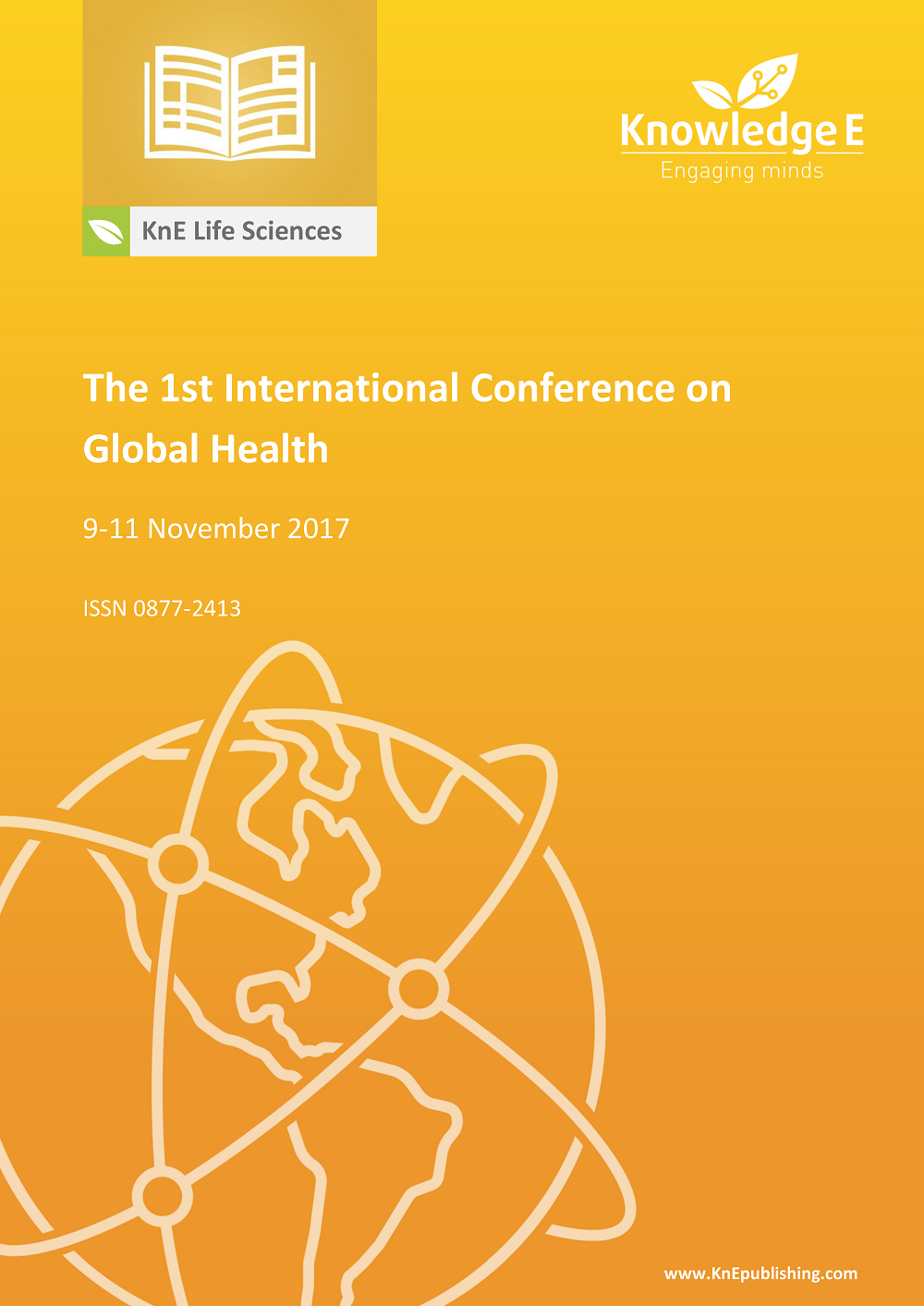Differences in the Cardiorespiratory Fitness of Employees of PT Pos Indonesia Regional IV Jakarta Based on Body Mass Index and Other Factors
DOI:
https://doi.org/10.18502/kls.v4i1.1386Abstract
Low cardiorespiratory fitness is associated with the risk of cardiovascular disease and hypertension. Cardiorespiratory fitness in workers is low. This study examined differences in cardiorespiratory fitness based on body mass index (BMI), body fat percentage, dietary intake, physical activity, smoking status, and sleep quality. The study design was cross-sectional, and it was conducted between April and May 2016 with 124 sedentary employees (66 men and 58 women) of PT Pos Indonesia Regional IV Jakarta. Cardiorespiratory fitness was measured by the YMCA (Young Men’s Christian Association) 3-min step test.Chi-square was conducted to determine differencesin the cardiorespiratory fitness status based on Body Mass Index (BMI), body fat percentage, physical activity, smoking status, and sleep quality. Independent T-test was conducted to determine the mean differences dietary intake based on cardiorespiratory fitness.The results showed that 55(44.4%) of the 124 employees had poor cardiorespiratory fitness.BMI and body fat percentage, in addition to dietary energy intake, carbohydrate intake, and iron intake, were associated with significant differences in cardiorespiratory fitness. Based on these results, employees are advised to monitor their BMI and body fat regularly, increase their levels of physical activity, and consume a nutritionally balanced diet.
References
Aspenes, S., Nielsen, T., Skaug, E., Bertheussen, G., Ellingsen, O., Vatten, L., and Wisloff, U. 2011.Peak oxygen uptake and cardiovascular risk factors in 4631 healthy women and men.Journal of the American College of Sports Medicine: 1465-1473.
Bernadot, D. 2012.Advance sport nutrition 2nd ed. United States: Human Kinetics.
Brodney, S., McPherson, R., Carpenter, R., Welten, D., and Blair, S..2001, Nutrient intake of phisically fit and unfit men and women.Journal of the American College of Sports Medicine: 459-467.
Brownlie, T., Utermohlen, V., Hinton, P., Giordano, C., and Haas, J.2002, Marginal iron deficiency without anemia impairs aerobic adaptation among previously untrained women. American Journal of Clinical Nutrition 75: 734-742.
Budiasih, K. 2011. Faktor-faktor yang mempengaruhi kebugaran jasmani karyawan di PT Amoco Mitsui Indonesia tahun 2011. SkripsiS. Ked., Fakultas Kedokteran Universitas Pembangunan Nasional.
Buysse DJ, Reynolds, CF, Monk, TH, Berman, SR andKupfer, DJ. 1989. The Pittsburgh Sleep Quality Index: A new instrument for psychiatric practice and research.Psychiatry Research 28:193-213.
Coburn, J.,&Malek M. 2012.NSCA’s essential of personal training-2nd edition, United States: Human Kinetics.
Corbin, C., Welk, G., Corbin, W., & Welk, K. 2008.Concepts of physical fitness: active for wellness14th ed.New York: Mc Graw Hill.
Diana, D., Basuki, B., & Kurniarobbi, J. 2009.Low physical activity work-related and other risk factors increased the risk of poor physical fitness in cement workers.Med J Indonesia 18 (3): 203-207.
Erlenbursch, M., Haub, M., Munoz, K., MacConnie, S., & Stillwell, B. 2005. Effect of high-fat or high-carbohydrate diets on endurance exercise: a metaanalysis.International Journal of Sport Nutrition and Exercise Metabolism 15: 1-14.
Fagerstorm, K., & Schneider, N. 1989. Measuring nicotine dependence : a review of the Fagerstorm Tolerance Questionnaire. J Behav Med 12(2): 159-182.
Fauziyana, N. 2012. Hubungan status gizi, ktivitas fisik, dan asupan gizi dengan tingkat kebugaran karyawan PT. Wijaya Karya tahun 2012. SkripsiSGz., Fakultas Kesehatan Masyarakat Universitas Indonesia.
Finley, C., LaMonte, M., Waslien, C., Barlow, C., Blair, S., andNichaman, M. 2006.Cardiorespiratory fitness, macronutrient intake, and the metabolic syndrome: The Aerobics Center Longitudinal Study.American Dietetic Association 106: 673- 679.
Flogel, A., Wientzek, A., Bachlechner, U., Jacobs, S., &Drogan, D. 2014.Linking diet, physical activity, cardiorespiratory fitness and obesity to serum metabolite networks: findings from a population-based study.International Journal of Obesity38: 1388-1396.
Fogelholm M., Malmberg, J., Suni, J., Santila, M., Kyrolainen, H., Mantysaari, & M. 2006. Waist circumference and BMI are independently associated with the variation of cardiorespiratory and neuromuscular fitness in young adult men.International Journal of Obesity30: 962-969.
Gibson, R. 2005.Principles of nutritional assessment2
Hoeger, W., & Hoeger, S. 2011.Lifetime physical fitness and wellness: a personalized program 7th ed. Canada: Cengage Learning.
Hong, S., Lee, J., Park, J., Lee, M., Kim, J., and Kim, K. 2014.Association between cardiorespiratory fitness and the prevalence of metabolic syndrome among Korean adults: a cross sectional study. BMC Public Health. 14: pp. 481.
Kenney, W., Wilmore, J., &Costille, D. 2012.Physiology of sport and exercise5th ed.United States: Human Kinetics.
Konig, D., Vaisanen, S., Bouchard, C., Halle, M., Lakka, T., &Baumstark, M.2003.Cardiorespiratory fitness modifies the association between dietary fat intake and plasma fatty acids.European Journal of Clinical Nutrition57: 810-815.
Laukkanen, J., Laaksonen, D., Lakka, T., Savonen, S., &Rauramaa, R. 2009.Determinats of cardiorespiratory fitness in men aged 42 to 60 years with and without cardiovascular disease. Am J Cardiol103: 1598-1604.
Lewis, J., Clark, J., LeBlanc, W., Fleming, L., Caban-Martinez, A., Arheart, K., et al.2011. Cardiovascular fitness levels among American workers.J Occup Environ Med53(10): 1115-1121.
Nieman, D. 2011.Exercise testing and prescription : a health-related approach7
Nieman, D., & Lee, R. 2007.Nutritional assessment5
Physical Health Personal Training (PHPT). 2016. Endurance test. www.phpt.co.uk (accessed March, 8 Maret 2015).
Ruzic, L., Heimer, S., Durakovic, M.,&Matkovic, B. 2003. Increased occupational physical activity does not improve physical fitness.Occupational and Environmental Medicine 60: 983-985.
Sander, M., Ejisvogels, T., Verheggen, R., Poelkens, F., Hopman, M., Jones, H., &Thijssen, D. 2012.Impact of physical fitness and daily energy expenditure on sleep efficiency in young and older humans.Gerontology 59: 8-16.
Tuntian, I. 2012.Hubungan Tingkat Aktivitas Fisik Dengan status kebugaran pada pekerja laki-laki bagian pengemasan perusahaan A di Bandung.Thesis, Fakultas Kedokteran Universitas Indonesia.
Unverdorben, M., Van der Bijl, A., Potgieter, L., Venter, C., Munjal, S., Qiwei, L., Meyer, B., &Rothig, H. 2008. Effects of differentlevels of cigarette smokeexposure on prognosticheart rate and rate pressureproductparameters.JCardiovascPharmacolTherapeutic13(3): 175–182.
World Health Organization (WHO). 2005.WHO steps surveillance manual: the WHO STEPwise approach to chronic disease risk factor surveillance.www.who.int/chp/steps/GPAQ/en (accessedFebruary, 28 2016).
Yuksel, M., Yildiz, A., Demir, M., Bilik, M., Ozaydogdu, N., Aktan, A., Isik, F., Demir, S., Yazgan, U., &Toprak, N. 2014.Effect of sleep quality on hemodynamic response to exercise and heart rate recovery in apparently healthy individuals.Clin Invest Med37(6): E352-62.
Zhu, W., Hooker, S., Sun, Y., Xie, M., Su, H., & Cao, J. 2014. Associations of cardiorespiratory fitness withcardiovasculardiseaseriskfactors in middle-agedChinesewomen: a cross-sectionalstudy.BMC Women’sHealth14: 62.

